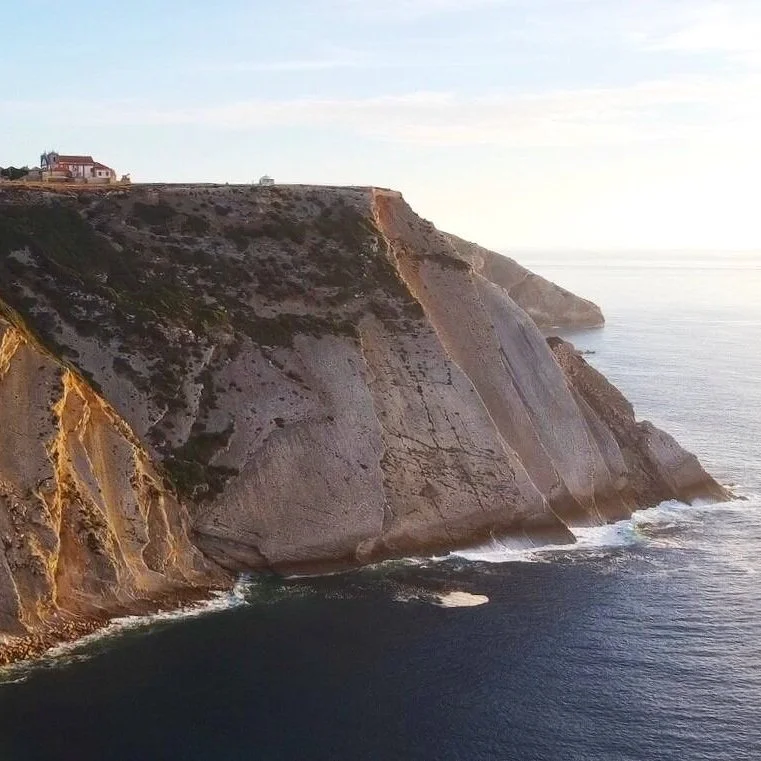What will you discover between Sesimbra and Costa da Caparica?
On a single day, witness a dried-up sea transformed into gypsum, and gypsum creating mountains. See oceans being formed, deformed, tilted, uplifted and exposed to the surface. See dinosaurs walking and swinging their tails. Touch turtles, corals and sharks.
Observe old marine ecosystems and past sea level changes, with seas turning into rivers, and rivers changing theirs courses during catastrophic events. Discover rivers transporting gold, coastal landscapes evolving and forming amazing beaches alongside sand dunes. Discover 200 millions years of the Earth history along 30 km of the beautiful southern Lisbon Coast.
-
Rocks & minerals
Fossils & dinosaurs
Faults & folds
Formation of ocean
The salt of the Earth
Past climate change
Geology & culture
-
Easy to moderate depending on/adjusted to the participants physical capabilities.
Travel between field stops will essentially be done by car. Participants will only be required a maximum of 10 minutes walk (less than 1 km) in each locality on easy to moderate terrain conditions.
Suitable for children and senior participants.
-
Sesimbra Castle
Gesseira de Santana (Gypsum Quarry)
Cabo Espichel (Cape)
Penedo Norte Beach
Lagoa da Albufeira (lagoon)
Adiça Beach (old gold Mine)
Costa da Caparica
-
Door to door field trip transportation*
Highly qualified and specialised geological field tour guide
Digital tour guidebook and GPS locations with description (.kmz format)
Lunch, snacks and water (several options)*
Geo Logica t-shirt made in Portugal
Personal insurance*
Carbon offset*
A day full of geo memories to remember for the rest of your life
-
Prices vary depending on the number of participants and travelling comfort chosen.
Fill in the field trip form using the button below to get a quote*
More about what you will discover on this trip
-
Compare the age of our planet to a road trip. It has been already a 4500 km long journey in which mankind only came aboard 3,6 kilometres ago.
Come with us to understand how old is our planet and imagine this age when comparing with the timescale of human existence. Learn the different Eons, Eras, Periods, Ages and Stages of the Earth’s history. In the process understand how Earth’s dating is done, through practical experiences to explain the main geological principles.
-
We all recognise many different types of rocks. But how can we distinguish them?
How are rocks classified? What do they mean? How were they first formed? How were they transformed throughout geological time? How can they tell us the history of our planet?
Answer all these questions while experiencing how the pioneering scientists came up with the main geological concepts.
-
Everything has a beginning and an end. Oceans are no exception. Geologists call this the Wilson cycle. There are many evidences of this process called oceanization or rifting along the Portuguese Atlantic coast.
Witness the 200 Million years old history of the opening of the Atlantic Ocean. Understand how the American and European plates broke apart during the fragmentation of Pangea Super-continent.
-
Observe old marine ecosystems recorded and preserved in the rocks. Literally touch “in situ” fossils of turtles carapaces, sea urchins, crabs, corals, sharks teeth and wale and dolphin bones.
Understand how this 5 millions years old remnants of life can show us the environmental changes that occurred since then until the present day. Recognise and witness past sea level changes, with deep water seas turning coastal areas and then rivers.
-
When oceans and seas dry-up huge amounts of salt are deposited in a short amount of time, geologically speaking. Often this process ends up forming thick sequences of so called evaporites - i.e. halite (rock salt), gypsum, anhydrite, etc. Within time, evaporites and overlaying sediments get buried, dehydrated and consolidated with sediments getting denser than evaporites/rock salt. This density contrast results in upward movement of evaporites creating salt domes, i.e. salt-cored mountains. In Portugal there are excellent examples of salt domes.
-
Have you ever seen dinosaur footprints? There are many places in Portugal where it’s possible to visit and observe the steps of these ancient giants. Here, between 252 to 66 Millions years ago dinosaurs walked along Mesozoic beaches and deltas, leaving their footprints behind. Alone or in groups, hunting or simply passing-by, their marks were recorded on the sediments. Come with us not only to learn how to recognise these so called icnofossils, but also discover how marked sediments were buried and solidified and now exposed in such weird places such as cliffs, quarries and beaches.
-
During 5 millions years ago sea level started to drop and the Arrábida mountain was being formed. The Pre-Tagus river, which flew from Central Iberia Peninsula into the Atlantic Ocean, had its rivermouth located approximately where is today Lagoa da Albufeira. Gold eroded inland was transported hundred of kilometres to be deposited here. Around 2,5 millions years ago a tectonic event created an huge fault system to where Pre-Tagus river was diverted, creating the present day Tagus River.
-
Although usually unaware, we are all fascinated by geology. Kings, clergy, philosophers, artists, architects, engineers at some point, all the greatest minds looked into breathtaking landscapes, amazing geological locations, and realised how powerful, inspirational and singular these were. That is why so often geowonders are involved in popular myths and crowned by the ingenuity of human minds in the form of great monuments. Discover the geohistory behind history.









